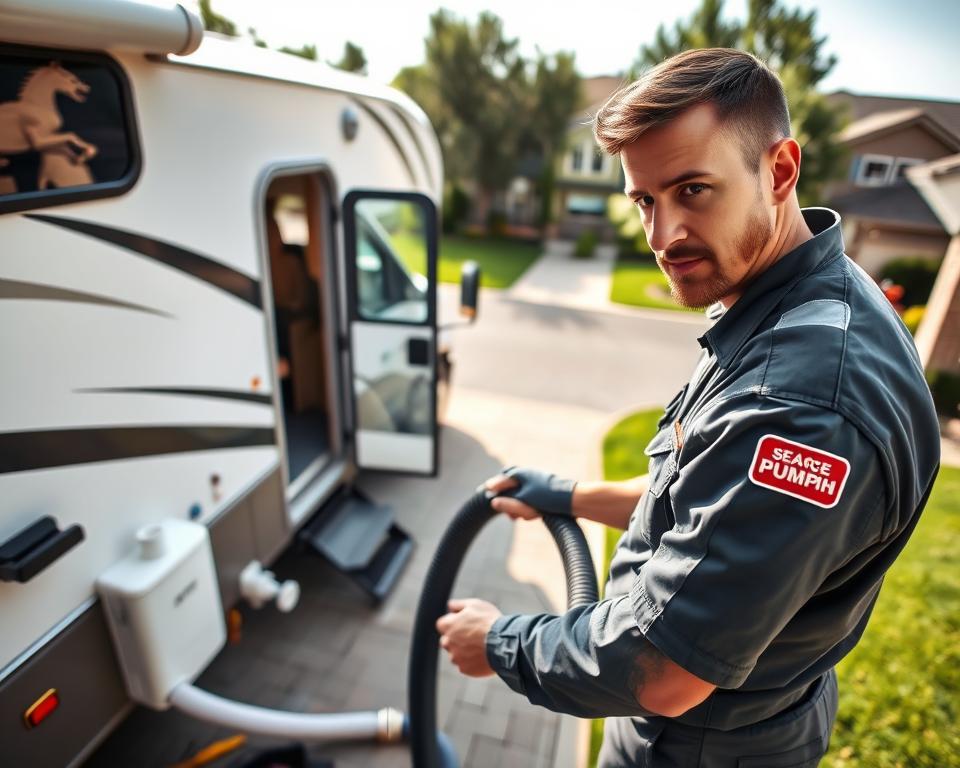RV Black Water Tank Pump Guide & Maintenance Tips
Thinking about your RV adventures, have you pondered the importance of the black water tank pump? A crucial aspect of your RV’s hygiene system is the black water tank pump. To ensure your travels are uninterrupted, proper maintenance is key. You’ll find crucial information in this guide about managing your RV’s waste water pump. Recognizing its significance will lead to improving its operation and making your RV adventures more fun.
Key Observations
- Effective waste management heavily relies on the RV black water tank pump.
- Keeping up with regular maintenance will help your RV waste water pump last longer.
- Having knowledge of the system’s components improves in problem-solving.
- Safe dumping practices are essential for both hygiene and the environment.
- Winterizing your RV black water tank system can prevent costly repairs.
- A clean RV sanitation pump helps prevent blockages and bad smells.
Understanding RV Water Tanks
Many RV owners may not fully grasp the importance of different water tanks for smooth camping using RV waste pump. Understanding the roles of the RV fresh water, gray water, and black water tanks is crucial. Each plays a unique role and needs proper care.
The purpose of the RV fresh water tank is to store water that is safe to drink. Drinking, cooking, and maintaining hygiene are the uses for this water. Maintaining the cleanliness of this tank and the safety of its water is crucial. Fresh water is crucial for hydration and health during travels.
On the other hand, the RV gray water tank collects wastewater from sinks and showers. This tank can quickly become full, requiring frequent checks and draining. Correct management of the gray water tank is vital for a clean RV interior.
Toilet waste is held in the RV black water tank, making it a critical component. To avoid smells and the buildup of waste, constant attention is required. Employing appropriate tank chemicals enhances condition and experience. Knowing how to care for each tank makes RV trips more enjoyable.
Defining the RV Black Water Tank Pump
This RV black water tank pump plays a crucial role in the sanitation of recreational vehicles. The pump’s function is to move waste to the appropriate disposal areas. To maintain it correctly and avoid expensive problems, you need to know how it works.
Sewer pumps are one of the various types of pumps that RV owners can select. The macerator pump is a favorite because it grinds waste, making disposal faster. This feature is very helpful at dump stations that are busy.
A quality RV black tank pump is crucial for waste management. This pump contributes to a clean and comfortable environment inside the RV. Knowing how your pump works and checking it often will improve your overall RV experience.
Understanding the Parts of Your Black Water Tank System
Understanding the RV black water tank system is crucial for efficient waste management. There are several key components that work in unison to guarantee proper operation. The most critical component, the black water tank, holds waste from the RV’s toilet. Made of sturdy materials, it’s designed to endure various conditions.

The system’s pump plays a significant role, transferring waste to a designated dump station. It is indispensable for RV owners. Playing a vital role as well are sewer hoses, which provide a flexible connection between the tank and the dump station. Made to prevent leaks and keep odors contained, these hoses ensure a clean way to dispose of waste.
Connection ports are vital for attaching sewer hoses, which helps in the effective transfer of waste. Termination valves are crucial for managing waste flow. They prevent backflow and spills during disposal, preserving sanitation.
For RV owners to maintain their sanitation system efficiently, they need to be familiar with these essential components. This knowledge is key for troubleshooting issues during travel or use, enhancing the overall RV experience.
Proper Usage of the RV Black Water Tank Pump
Knowing how to use the RV sanitation pump well greatly makes better your experience as an RV owner. Knowing how to operate the black tank properly is vital for a smooth-running system. A crucial step is to make sure you flush the tank well after each use. This practice helps avoid the buildup of solid waste, which might result in blockages and other issues.
Regularly inspecting your RV sanitation pump will ensure it’s functioning properly. By doing this, you can prevent any unpleasant issues while you’re on the road. Using toilet paper that is designed for RVs is also very important. This kind of paper is made to break down fast, which lowers the chance of clogs.
Maintaining closed termination valves, except when emptying, is another crucial practice. It helps to stop odors from spreading. Using tank deodorants and cleaners will also help keep the system smelling good and clean. Adhering to these guidelines improves your experience with the RV black water tank.
| How to Properly Use Your Black Tank | Advantages |
|---|---|
| Make Sure to Flush with Enough Water | Keeps solid waste from causing blockages |
| Check the Pump Operation Regularly | Helps ensure it’s working as it should |
| Only Use Toilet Paper Designed for RVs | Helps prevent blockages |
| Always Keep the Termination Valves Closed | Lowers the amount of odor |
| It’s Good to Use Tank Deodorizers and Cleaners | Keeps the system smelling fresh and clean |
Essential Maintenance Tips for the Black Water Tank Pump
Regular maintenance is essential to make sure your RV’s black water tank pump lasts and works well. One aspect of this is using the correct chemical treatments that are intended for these tanks. These treatments are effective at breaking down waste and stopping bad smells.
Making sure there’s enough water when you use the toilet is also very important. This ensures that waste goes smoothly into the tank, which helps to minimize the risk of buildup. In addition, it’s important to regularly deep clean the tank and all the parts that go with it. Use the recommended tools for this important task.
Always monitor the tank levels to avoid any issues. Deal with any leaks or overflows immediately. It’s important to empty the tank regularly so that solid waste doesn’t build up. Creating a maintenance schedule helps ensure a trouble-free RV experience.
| Upkeep Task | How Often | Description |
|---|---|---|
| Look at levels | With each trip | Check that the tank isn’t filled beyond capacity to prevent leaks. |
| Apply chemical treatment | Once you’ve dumped | Use treatments to help break down waste well. |
| Do a system flush | Once a month | Use a cleaning product to keep the tank clean. |
| Inspect the pump | Before any long travel | Check for wear and tear to prevent breakdowns on the road. |
| Tank emptying | Depending on the need | When the tank is full, empty it, preferably at official dump stations. |
Making sure you follow these important maintenance practices will help your black water tank pump work as it should. This will enhance your RV trips significantly.
Common Black Water Tank Pump Issues and How to Solve Them
Addressing issues with the black tank pump might seem intimidating. Many RV owners encounter various RV black tank problems such as clogs, leaks, or persistent odors. Addressing these issues early can help you save time and avoid expensive repairs later.
Start by inspecting the hoses connected to the black tank pump. Blockages often occur in these areas, leading to ineffective pumping. Take the hoses off and see if there’s any buildup or dirt inside. If there are any blockages, clean the hoses well before you connect them again.
The next step is to evaluate the seals around the pump and the tank. Damaged seals can result in leaks that may go unnoticed until significant damage has occurred. If you find any seals that are not working properly, replace them right away to stop more problems from happening.
If you have smells that won’t go away, using enzyme treatments can help. These treatments help to dissolve waste and get rid of bad smells. For the best outcome, make sure you follow the instructions from the manufacturer.
This table provides a quick overview of common problems and their solutions:
| Concern | What Might Be the Reason | Solution |
|---|---|---|
| Clogs | Dirt or waste in the hoses or tank | Make sure to check and clean the hoses |
| Leaks | Damaged seals | Check the seals and replace them if needed |
| Unpleasant smells | Waste buildup | Try using enzyme treatments |
| Pump isn’t functioning | Issues with the wiring | Inspect the connections and battery |
Recognizing the warning signs early on can prevent minor issues from turning into major problems with your RV black tank. If you maintain it regularly and keep a close watch, your black tank pump will last longer, which will make better your RV experience.
How to Clean Your RV Black Water Tank Pump
To ensure hygiene and the proper functioning of your RV’s plumbing, you need to keep the black water tank clean. Aim to minimize odors and ensure everything functions smoothly by rinsing with fresh water after use. This helps to stop waste from building up and keeps the tank in good condition.
For a deeper clean, use cleaning solutions made for black water systems. These products are good at dissolving waste and fighting bad smells. Pour water and the cleaning solution into the tank, and allow it to soak. Having a built-in flush system in your RV simplifies the cleaning process.
Driving with sharp turns or using sloshing techniques can help to stir up the contents of the tank. This helps loosen residue on the tank walls. These cleaning methods help the sensors to be more accurate, which can help you avoid problems with sewage.
Ensuring Safe Dumping Procedures at RV Stations
Knowing the proper way to behave at RV dump stations is important so that everyone can use them comfortably. When you arrive at a dump station, check that your RV is in the right spot. Then, get your gear ready for dumping.
To make sure the process goes smoothly, follow these steps closely:
- Check that your sewer hose is tightly connected to the station’s outlet.
- Start by opening the black water valve to let the sewage flow out.
- When the black tank has finished emptying, close its valve. Then, open the gray water valve to clean the hose with the less dirty water.
- After you’re finished, carefully disconnect your hose so nothing spills.
- You should always clean your hoses with drinking water and put them away right away.
It’s also critical to follow local waste disposal laws. Many places have rules you must obey to protect the environment. If you don’t follow these rules, you could get fines or other penalties.
Being respectful at RV dump stations helps to make the experience more pleasant for everyone. By maintaining a clean area and adhering to the rules, you demonstrate care for the community. These kinds of actions help to build a culture of responsibility among RV lovers and encourage camping habits that are environmentally friendly.
How to Winterize Your RV Black Water Tank System
Winter preparation of your RV tanks is vital to protect the black water system from freezing. Proper preparation is important to prevent damage caused by water freezing inside the system. To make sure your RV black tank is effectively cared for in the winter, you need to follow specific steps.
- Start by fully draining the black water tank using the appropriate pump and connections.
- After that, bypass the water heater so that water doesn’t get into it and build up.
- Use RV-specific antifreeze, as regular antifreeze can be toxic and harmful to the environment. Pour the antifreeze into the system according to the product instructions.
- Make sure to leave all faucets and drains open so that any leftover water can get out and the antifreeze can circulate.
- The last step is to check that all access panels are sealed and secure to prevent water from getting in during the winter months.
RV owners can protect their black water tank systems from the harsh effects of winter by following these winterization steps. This kind of planning helps you avoid having to pay for expensive repairs or maintenance when the seasons change.
Wrapping It Up
Successful RV ownership relies heavily on efficient maintenance of the RV black water tank. If you understand how to use the black water tank pump well and follow the maintenance tips in this guide, your travels will be more enjoyable. By taking good care of your equipment, you’ll extend its life and simplify the process of managing waste in your RV. This makes travel less daunting.
Understanding your RV’s black water system is crucial for tackling issues as they arise. If you use good maintenance, troubleshooting, and cleaning techniques, you can prevent unexpected problems. This lets you enjoy worry-free road trips. Getting help from trusted services like All in Sanitation can support your maintenance efforts. You can get the essential products and support for top-quality care from them.
Proper RV ownership requires you to be attentive and take good care of every part of your vehicle, including the black water tank. With this knowledge, you’re prepared to explore freely. You’ve made all the correct decisions to guarantee a wonderful journey for yourself and those with you.


